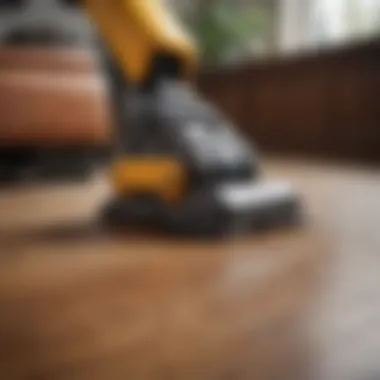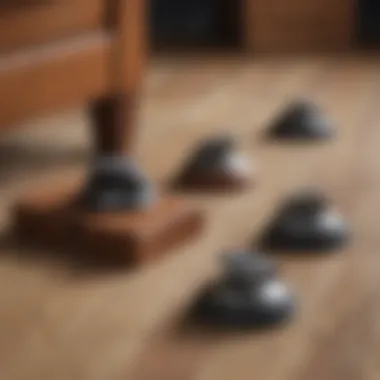The Essential Guide to Wood Floor Furniture Grippers


Intro
When it comes to furnishing your home, you might not think about the small details that could make or break your wood floors. Furniture grippers are just one of those essentials that can save your flooring from potential damage while also ensuring that your pieces stay put. They might seem like a minor accessory, but these tools play a crucial role in maintaining your home’s aesthetic integrity and functionality. Understanding how they work and the variety available can help you make informed choices about creating a comfortable and appealing living space.
As you explore the universe of grippers, you'll encounter various types designed for an array of furniture styles and floor finishes. The right gripper can prevent those annoying furniture slides, keeping chairs and tables exactly where you want them. But more than that, they act as guardians for your gleaming wooden floors, shielding them from those pesky scratches and scuffs that seem to appear out of nowhere.
Delving into these topics will not only enhance your home environment but also inspire confidence in any design choices you make on a beautiful wood surface. This article provides a thorough guide so you can effectively protect and stylishly arrange your furniture.
Preamble to Furniture Grippers
In a world where aesthetics and functionality go hand in hand, furniture grippers emerge as unsung heroes in home design. Most folks tend to overlook them, yet their significance is palpable, especially in spaces with beautiful wood floors. Understanding furniture grippers can provide homeowners with the insight needed to maintain their interior ambiance while safeguarding their investments.
Furniture grippers serve primarily to anchor furniture in place, keeping it steady and secure on slick surfaces. The right type of gripper can make a huge difference. Not only do they prevent costly mishaps, like scratches and dents on your hardwood floors, but they also contribute to the overall safety and comfort of your living spaces.
Moreover, furniture grippers enhance the aesthetic harmony within a room. They can be subtle, blending seamlessly with your flooring and furniture, or they can be a distinct design element in themselves. With the myriad of options available, each designed with different functionality in mind, choosing the right gripper becomes an art form of sorts—much like picking the perfect shade of paint for an accent wall.
The importance of furniture grippers cannot be overstated. They protect your flooring investment from the wear and tear that comes with everyday life. Furthermore, they help maintain the tidiness of a room, making it look well-kept and organized, which is a crucial aspect for homeowners and hosts alike.
"The right furniture gripper is like a good friend—always there to support you, even when the floor gets a bit slippery."
As we dive deeper into this article, we’ll navigate through what these tools truly are, exploring their types, utility, and best practices for maintenance. This journey aims to enlighten homeowners, interior design aficionados, and anyone who values both beauty and practicality in their home environment.
The Role of Wood Floor Furniture Grippers
When it comes to creating a comfortable living space, wood floor furniture grippers play a critical role that often goes unnoticed. These unsung heroes not only stabilize your cherished pieces but also preserve the integrity of your beautiful wood floors. By understanding their function, you can ensure your home remains both practical and aesthetically pleasing.
Preventing Furniture Movement
One of the primary functions of furniture grippers is to prevent movement, especially in high-traffic areas. Imagine the frustration of having that gorgeous dining room table slide every time someone leans on it, disrupting the cozy ambiance. Grippers act as a barrier, holding furniture firmly in place. This means you can enjoy your space without constantly rearranging your chairs or scooting that sofa back into position.
Grippers like rubber ones create friction with floor surfaces, significantly reducing the chance of slipping. Their gripping power is invaluable for heavy pieces, such as recliners or large bookcases, where the risk of them toppling is a genuine concern.
Moreover, some furniture grippers come equipped with transparent materials that blend seamlessly with your decor. They won’t attract attention but will ensure peace of mind. By employing these simple tools, you can maintain order in your home, creating a comforting environment for both residents and guests.
Protecting Wood Floors from Damage
Keeping wood floors in pristine condition requires constant vigilance, and furniture grippers are essential in this endeavor. Wood can be sensitive to scratches and dents, which can detract from its natural beauty over time. By utilizing furniture grippers, you create a protective buffer between your furniture and your flooring.
Felt pads are a popular choice for this purpose. They act as soft cushions that distribute weight evenly, thus minimizing pressure points where scratches often occur. These pads soak up casual impacts, preventing ugly marks and preserving the finish on your wooden floor.
Additionally, grippers can help guard against discoloration from direct contact with heavier furniture. Over time, without these protective measures, the risk of indentations and fading increases tremendously, which could lead to costly repairs or refinishing.
"A little prevention goes a long way; investing in furniture grippers is akin to an insurance policy for your wood floors."
Ultimately, understanding and using wood floor furniture grippers can save both time and money. They help maintain a beautiful home where every piece of furniture serves its purpose without the worry of movement or damage. For those invested in their interiors, these tools aren't just beneficial; they are indispensable.
Types of Furniture Grippers for Wood Floors


When it comes to safeguarding wood floors while ensuring your furniture stays right where it ought to be, furniture grippers are nothing short of invaluable. The realm of these grippers offers a variety of options, each with distinct features and benefits. This section aims to unravel the different types of grippers, helping you make an informed choice that suits your needs. Understanding this will not only protect your floors but also can enhance the longevity and appearance of your furnishings.
Rubber Grippers
Rubber grippers are perhaps the most common type you'll come across. They stick directly to the bottom of furniture legs, offering a grip that’s quite remarkable. Made from durable rubber materials, these grippers are designed to provide friction between the furniture and the floor. One major advantage of rubber grippers is their effectiveness on various floor surfaces, especially hardwood.
- Key Benefits:
- High traction: Prevents undesirable movement, especially in high-traffic areas.
- Shock absorbency: Reduces noise and cushions against heavy furniture impacts.
- Resistance to wear: Unlike other gripper varieties, rubber tends to maintain its functionality over extended periods without losing grip.
However, there are a couple of things to keep in mind. Rubber can sometimes leave marks or scuffs on your wooden floors if it's not the right kind. Furthermore, if exposed to excessive heat, rubber may degrade over time. Hence, it’s essential to pick a high-quality rubber that’s designed specifically for such applications.
Felt Pads
Felt pads present a softer alternative to rubber, often fashioned for delicate wooden surfaces. These pads adhere to furniture legs and create a buffer that allows for easy gliding, which is crucial for moving furniture around without scratching your beautiful wood flooring.
- Advantages:
- Gentle on floors: The soft nature of felt helps in preventing scratches and dents.
- Ease of movement: They make it incredibly easy to rearrange furniture without any hassle.
- Aesthetic flexibility: Felt pads come in various colors and textures, allowing you to choose those that blend seamlessly with your interior design.
Despite the benefits, felt pads aren’t without their limitations. They can wear down faster than rubber, especially under heavy furniture, meaning regular replacements may be in your future. Additionally, water can ruin them, so there’s that little caveat to consider.
Silicon-Based Options
Silicon-based furniture grippers are an innovation in floor protection. These modern grippers combine the flexibility of silicone with high-friction surfaces, providing a remarkable grip without the drawbacks of rubber or felt.
- Benefits include:
- Flexibility: Silicon's adaptable nature allows for a snug fit on various furniture feet, preventing slippage.
- Durability: They are resistant to wear, weathering, and don't degrade easily.
- Easy to clean: Unlike felt, which absorbs dirt, silicon can simply be wiped clean, maintaining its appearance over time.
Nonetheless, remember that these might have a slightly higher price point compared to traditional rubber or felt pads. It’s important to weigh these factors against your long-term needs for furniture grippers.
In summary, choosing the right type of furniture gripper can greatly affect not only the condition of your wood floors but also the ease of rearranging your home. Each variety has its unique strengths, so don’t rush the decision!
No matter which type you lean towards, the right choice will make a substantial difference in preserving both your furniture and flooring.
Installation Techniques
When it comes to making the most of your wood floor furniture grippers, how you install them can make a world of difference. Proper installation techniques are vital not just for longevity but also for ensuring that your furniture stays put without damaging your beautiful wood floors. In this section, we’ll dive into the nuts and bolts of installation—making sure you get it right the first time.
Preparing the Floor Surface
Before jumping into gripper installation, it's crucial to ensure your floor is ready for the job. A clean and dry surface is paramount. Here’s what you need to do:
- Sweep or Vacuum: Remove dust, crumbs, and debris. Any little items left behind can create uneven surfaces, which can impact how well the grippers adhere.
- Spot Clean Stains: Use a slightly damp cloth with a mild solution if there are any noticeable stains or spills. Make sure the area dries completely before moving forward.
- Check for Damage: Inspect the floor for cracks or areas of wear. If you find some, you might wanna fix those before placing the grippers to ensure they stay secure.
By getting your floors prepped like this, you create a solid foundation for your furniture grippers.


Applying Adhesive Grippers
Adhesive grippers are a fantastic choice, but their effectiveness relies heavily on how they’re applied. Here's how to do it right:
- Choose the Right Spot: When deciding where to place the grippers, make sure they're directly underneath the legs of the furniture. This positioning maximizes stability.
- Peel and Stick with Care: Removing the backing should be done carefully to avoid dust and dirt coming into contact with the adhesive.
- Firm Pressure: Once positioned, press down firmly for at least 10-15 seconds. The heat and pressure from your hands helps to secure the adhesive.
- Let it Cure: It’s often overlooked, but allowing the adhesive to cure for a specified duration as outlined by the manufacturer can significantly improve its hold.
Ignoring these details can lead to short-lived effectiveness, so treat the application process with the attention it deserves.
Best Practices for Felt Pads
Felt pads offer a softer touch for your flooring. They also protect against scuffing and other marks. Here are some best practices for installing felt pads effectively:
- Select the Right Size: Make sure you choose pads that match the size of your furniture legs. If the pads are too small, they won’t provide adequate coverage.
- Clean the Furniture Legs: Just like with the floor, clean the furniture legs where the pads will be applied. A bit of rubbing alcohol can do wonders in removing oils and residues.
- Press Firmly: After applying the pad, press down securely. This ensures they stick well without peeling off over time.
- Regularly Check: Don’t forget to inspect them from time to time to make sure they are still securely in place. If they start to look worn, replace them to keep protecting your floors.
Using these best practices helps maximize the life of your felt pads while protecting your floors at the same time.
In summary, proper installation techniques not only enhance the performance of your grippers but also extend their lifespan, safeguarding your investment in wood flooring. It's well worth the time and effort to get it right.
Maintaining Furniture Grippers
Maintaining furniture grippers is more than just a chore; it's a critical element in preserving both the integrity of your furniture and the beauty of your wood floors. Many homeowners might overlook how vital this maintenance is, thinking these devices can just be installed and forgotten. However, neglecting their upkeep could lead to various frustrations, including furniture damage and increased wear on pristine flooring. This section will guide you through the importance of regular gripper maintenance and tips for inspections and replacements.
Regular Inspections
Regular inspections are essential to ensure that furniture grippers perform their intended function effectively.
- Identifying wear and tear: Grippers can wear down over time, losing their effectiveness. Check for signs of deterioration, such as peeling felt pads or cracked rubber. If any gripper appears to be aging, it might need a closer look.
- Frequency of inspections: Ideally, inspect your grippers every few months, or after major events in your home, like a large family gathering or a furniture rearrangement. This will help you catch any issues before they become more significant problems.
- Check the fit: Ensure that grippers still fit snugly under the legs of your furniture. If they’ve become loose, your furniture is more susceptible to slipping or damaging your floor.
Maintaining an eye for these factors can save you from painful surprises later on. The aim is to keep your space functional and beautiful, without unexpected scrapes on those lovely wood floors.
When to Replace Grippers
Knowing when to replace grippers is as crucial as inspecting them. There are specific indicators that tell you it’s time to say goodbye to an old gripper and welcome a fresh one into your home.
- Visible damage: If a gripper shows any obvious signs of physical damage, like cracks in rubber or flattened felt pads, it’s time to replace them. Damaged grippers can’t do their job effectively and might even scratch your flooring.
- Loss of adhesion: If adhesive grippers have started to lose their ability to stick, often observed when you find furniture moving without much effort, it indicates that the adhesive properties have deteriorated. Don't hesitate to replace them.
- Alternative compatibility: If you’ve decided to change your furniture or decor, you might need to revisit your choice of grippers. Choosing new types that match your updated interior can elevate your home’s aesthetics while ensuring better functionality.
Regularly monitoring your furniture grippers and being proactive about replacements can lead to a longer life for both your grippers and your wood floors. Maintaining an organized home means taking care of the small things, including the unsung heroes like furniture grippers.
Choosing the Right Gripper for Your Furniture
Selecting the appropriate furniture gripper is not a trivial task. It involves assessing various elements to ensure effectiveness and compatibility with both your furniture and wood floors. A well-chosen gripper not only stabilizes your furnishings but also protects your flooring surfaces from potential damage, making it a vital consideration in any interior setting.
When you consider how much effort can go into rearranging furniture or preserving the integrity of your wooden floors, it becomes clear why choosing the right gripper is essential. The wrong choice can lead to unsightly scratches, constant adjustments of heavy items, or even accidents. Thus, understanding the specific attributes of your furniture and floors is crucial in making the best decision.
Evaluating Furniture Weight and Type
When selecting grippers, the first step is evaluating the weight and type of the furniture involved. Not all pieces of furniture are created equal; they come in various sizes, weights, and forms which can significantly influence what kind of gripper is appropriate.


- Heavy Items: If you have solid wood or leather sofas weighing a good amount, look for rubber or silicone grippers that can withstand substantial pressure without slipping. These are typically thicker and provide a firm grip to ensure stability.
- Lightweight Pieces: For lighter chairs or side tables, felt pads may be sufficient. They won’t overburden your floor and can effectively prevent scratches while being easy to move when needed.
- Furniture Legs Shape: The shape of the furniture legs also plays a role. Round legs may benefit from grippers with a deep cup design, whereas square or rectangular legs might need adhesive pads that cover a larger surface area.
Analyzing Wood Floor Characteristics
Another crucial aspect to consider is the inherent characteristics of your wood flooring. Different wood types, finishes, and textures may react differently with various material grippers.
- Wood Type: Certain hardwoods might be more susceptible to scratches, making it essential to choose softer grippers, like felt, for these surfaces. On the other hand, a harder, more durable finish may allow more options.
- Floor Finish: Consider whether your floor is treated with a protective finish. A high-gloss finish is more prone to show marks and residues. Therefore, a non-marking gripper is preferable in these cases.
- Surface Texture: Smooth floors might allow for a greater variety of grippers, while textured surfaces may hinder movement and require more grip. Also, ensure that the gripper adheres well without causing damage to the texture.
A well-informed choice can significantly prolong the life of your furniture and maintain the aesthetics of your floors.
Ultimately, understanding both the specifics of your furniture and the features of your wood flooring will lead you to make a productive decision. Just like in any home improvement task, informed choices can make all the difference between functional beauty and constant upkeep.
Environmental and Aesthetic Considerations
When discussing furniture grippers for wood floors, it’s vital to think about more than functionality. In today’s world, where environmental consciousness is becoming a lifestyle rather than just a trend, the impact of our choices stretches beyond the immediate benefits. It weaves into the very fabric of sustainable living and the aesthetics we cultivate in our homes.
Choosing Eco-Friendly Materials
Selecting eco-friendly materials for furniture grippers not only promotes sustainability but also aligns with the growing demand for more responsible consumerism. Many traditional materials contribute to carbon footprints and environmental degradation. In contrast, options like natural rubber, felt from recycled fibers, or even wood composites are gaining traction.
- Natural Rubber: This material is biodegradable and doesn’t release harmful chemicals into the environment, ensuring that your home decor supports eco-conscious values.
- Recycled Felt Pads: These provide a soft, protective layer for wood floors while minimizing waste. Sourcing felt pads made from recycled materials is an excellent way to decrease your environmental impact.
- Bamboo Grippers: Known for its rapid growth and renewability, bamboo presents a sustainable option that can also enhance your interior design with a natural look.
By investing in these materials, homeowners can express a commitment to both style and sustainability, proving that functionality does not have to come at the expense of the Earth.
Blending with Interior Decor
Aesthetic considerations play a crucial role in choosing furniture grippers. Grippers need not merely be utilitarian; they can harmonize with your interior design scheme and enhance the overall ambiance of a space.
- Color Coordination: Picking grippers that match or complement existing furniture or wood floor shades can elevate the room’s aesthetic appeal. For example, clear silicone grippers tend to disappear against light wood floors, while darker options can create a striking contrast.
- Design Versatility: Grippers come in various designs and styles, from sleek modern finishes to rustic options. Incorporating grippers that resonate with your home’s architectural style aids in creating a cohesive look.
- Creative Displays: Think outside the box! Some grippers can be displayed as part of decorative arrangements. It’s not just about what keeps furniture stable; sometimes it’s about what brings it all together visually.
"In interior design, every little detail matters, including items often overlooked, like furniture grippers. They can be a small, yet impactful, part of your overall aesthetic."
By recognizing the interconnection between environmental impact and aesthetic choices, homeowners and designers can curate spaces that reflect individual values while maintaining the elegance and tranquility that well-placed furniture grippers provide. Thus, selecting the right furniture gripper can enhance not only the physical sustainability of your home but also its visual harmony.
Finale
In bringing our exploration of furniture grippers to a close, it's vital to highlight their role in everyday living spaces. These small yet significant devices are not merely an afterthought in home design. Instead, they serve multiple purposes that enhance functionality and aesthetics alike. From ensuring stability of furniture to protecting the wood floors underneath, the benefits of using furniture grippers can’t be overlooked.
Summarizing the Benefits
The advantages of integrating furniture grippers into home settings are manifold:
- Prevention of Slippage: Particularly advantageous for dynamic environments, such as homes with children or pets, these grippers help to keep furniture in place. This security is paramount when hosting gatherings, ensuring that tables and chairs remain steadfast, even under pressure.
- Floor Protection: Wood floors can be quite an investment. Grippers act as a buffer, reducing the risk of scratches and dents that could detract from the wood’s natural beauty. By absorbing some of the impact, they can extend the longevity of your flooring, saving homeowners time and money on repairs.
- Design Harmony: A well-chosen gripper can seamlessly blend with a room's decor. Whether opting for a natural felt pad or a stylish rubber variant, they can complement the overall aesthetic without compromising functionality.
Given all these benefits, it becomes evident that furniture grippers are an essential component of interior design. They provide practical solutions while enriching the visual and functional experience of living spaces.
Future Trends in Furniture Gripping Solutions
The realm of furniture grippers isn’t stagnant. As homeowners place increasing importance on both style and sustainability, the market is seeing shifts towards more innovative solutions:
- Eco-Friendly Materials: The future of furniture grippers pivots towards sustainability. With more consumers becoming eco-conscious, manufacturers are exploring biodegradable and recycled materials. This trend not only addresses environmental concerns but also aligns with the aesthetics of modern interior design.
- Smart Technology: Think of furniture grippers equipped with sensors, alerting homeowners to the shifting position of furniture. Integration with smart home systems may pave the way for enhanced living experiences, improving safety and convenience.
- Custom Solutions: Bespoke grippers tailored to specific furniture types or unique flooring characteristics are on the rise. As consumers seek to personalize their homes, a one-size-fits-all approach is likely to give way to customized options that cater to individual preferences and needs.
As we look ahead, it's clear that furniture grippers will evolve, reflecting shifts in design ethos and consumer behavior. Staying abreast of these trends can help homeowners make informed decisions about their interior spaces and ensure they utilize the best solutions available.



